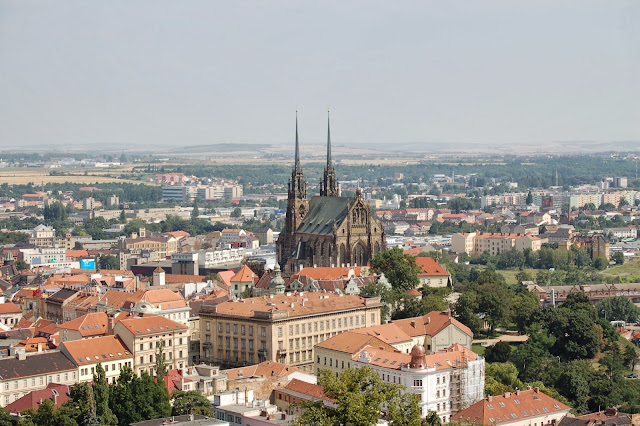Brno by population and area is the second largest city in the Czech Republic, the largest Moravian city, and the historical capital city of the Margraviate of Moravia. Brno is the administrative center of the South Moravian Region where it forms a separate district Brno-City District. The city lies at the confluence of the Svitava and Svratka rivers and has about 400,000 residents, its greater metropolitan area[6] is regularly home to more than 800,000 people while its larger urban zone had population of about 730,000 in 2004. Brno is the capital of judicial authority of the Czech Republic – it is the seat of the Constitutional Court, the Supreme Court, the Supreme Administrative Court, and the Supreme Public Prosecutor's Office. Beside that, the city is a significant administrative centre. It is the seat of a number of state authorities like Ombudsman, Office for the Protection of Competition[9] and the Czech Agriculture and Food Inspection Authority. Brno is also an important centre of higher education, with 33 faculties belonging to 13 institutes of higher learning and about 89,000 students. There is also a studio of Czech Television and the Czech Radio, in both cases by law. Brno Exhibition Centre ranks among the largest exhibition centres in Europe (23rd in the world). The complex opened in 1928 and established the tradition of large exhibitions and trade fairs held in Brno. Brno is also known for hosting motorbike and other races on the Masaryk Circuit, a tradition established in 1930 in which the Road Racing World Championship Grand Prix is one of the most prestigious races. Another notable cultural tradition is an international fireworks competition, Ignis Brunensis, that usually attracts one or two hundred thousand daily visitors. The most visited sights of the city include the castle and fortress Špilberk and the Cathedral of Saints Peter and Paul on Petrov hill, two formerly medieval buildings that form the characteristic cityscape and are often depicted as its traditional symbols. The other large preserved castle near the city is Veveří Castle by the Brno Dam Lake. This castle is the site of a number of legends, as are many other places of Brno. Another important monument of Brno is the functionalist Villa Tugendhat which has been included in the UNESCO list of World Heritage Sites. One of the natural sights nearby is the Moravian Karst.
History of Brno
Brno was recognised as a town in 1243 by Wenceslaus I, King of Bohemia, but the area had been settled since the 2nd century. It is mentioned in Ptolemy's atlas of Magna Germania as Eburodunum. From the 11th century, a castle of the governing Přemyslid dynasty stood here, and was the seat of the non-ruling prince. During the 14th century, Brno became one of the centres for the Moravian regional assemblies, whose meetings alternated between Brno and Olomouc. These assemblies made political, legal, and financial decisions. They were also responsible for maintaining regional records. During the Hussite Wars, the city remained faithful to Sigismund, Holy Roman Emperor. The Hussites twice laid siege to the city, once in 1428 and again in 1430, both times in vain. During the Thirty Years' War, in 1643 and 1645, Brno was the only city to succeed in defending itself against Swedish sieges, thereby allowing the Austrian Empire to reform its armies and to repel the Swedes. In recognition of its services, the city was rewarded with a renewal of its city privileges. In the years following the Thirty Years' War, the city became an impregnable Baroque fortress. In 1742, the Prussians vainly attempted to conquer the city, and the position of Brno was confirmed with the establishment of a bishopric in 1777. In 1805, The Battle of Austerlitz took place about 10 kilometers (6 miles) southeast of Brno. In the 18th century, development of industry and trade began, and continued into the next century. Soon after the industrial revolution, the town became one of the industrial centres of Moravia and the Austro-Hungarian Empire – sometimes referred to as the "Moravian Manchester". In 1839, the first train arrived in Brno. Together with the development of industry came the growth of the suburbs, and the city lost its fortifications, as did the Spielberg fortress, which became a notorious prison to which were sent not only criminals, but also political opponents of the Austrian Empire. Gas lighting was introduced to the city in 1847 and trams in 1869. Mahen Theatre in Brno was the first theatre building in Europe to use Edison's electric lamps, Thomas Edison then visited Brno in 1911 to see the theatre. During the "First Republic" (1918–1938), Brno continued to grow in importance – Masaryk University was established (1919), the state armoury and automotive factory Československá státní zbrojovka Brno was established (1919), and the Brno Fairgrounds were opened in 1928 with an exhibition of contemporary culture. The city was not only a centre of industry and commerce, but also of education and culture (see the section on notable people from Brno). In 1939, Brno was annexed by Nazi Germany along with the rest of Moravia and Bohemia. All Czech higher education institutions were closed down on 17 November including four universities in Brno. 173 students were sent to Sachsenhausen concentration camp and Kounic's students residence was transformed into Gestapo headquarters and prison. Brno was liberated on 26 April 1945 by Red Army after more than two weeks of heavy fighting. After the war, and the reestablishment of the Czechoslovak state, the majority of the ethnic German population (except antifascists, members of the resistance, mixed marriages, etc.) was expelled to Germany or Austria. The expulsion of some 20,000 Germans is referred to as Brno death march.

No comments :
Post a Comment